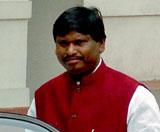New Delhi, Mar 7: Bhim Army chief Chandrashekhar Azad has taunted Bahujan Samaj Party chief Mayawati saying that she has lost her way. He also said that one will have to work for the larger interest of the society to bring about equality. Only the speeches cannot improve the condition of the Dalits, their participation in power must increase.
In an interview with media persons, Chandrashekhar said: "Members of minority community, Dalits and backward classes are being targeted in the country. Their rights are being taken away. Our workers want that they too should get equal share in political power. Keeping this in mind, we are going to form a new political party on March 15. Their (Dalits) issues will have to be raised. Mere speeches will not work for Bahujan society, one has to raise voice in their favour. They should get a share in power."
On the question that how he would find a foothold in view of large political base of the BSP, Chandrashekhar said, "We are not looking for an alternative. Look at the crores of Muslims, Dalits, members of backward community and minorities. We have to protect their interests. We have a large organisation in the state. Our Bharat Bandh was also successful".
On the question that with which party he will forge an alliance in 2022 after forming his party on March 15, Chandrashekhar said: "When we are forming our party then we don't need to go seeking alliance with anyone. Our party will be formed on the basis of some principles. Whoever will find it suitable will come close to us".
On meeting with Yogi government's former minister Om Prakash Rajbhar, he said that Rajbhar is not a controversial person. He is a big backward leader. He raises voice in favour of the backwards in the Assembly. He also supported us when I was in jail. We talked about how to stop the BJP and will take all necessary steps to prevent the BJP from coming back to power.
When asked why he had several run-ins with the police, Chandrashekhar said: "Ask this question to the police. Have I broken any law? Am I not a citizen of this country? There is no freedom of speech in the Yogi government. This is happening at the behest of the government. We are just opposing it".
Talking about the CAA, NRC and the NPR, he said: "We will not stage protest because the government does not want it. Any law which is wrong in our view will be opposed. This is a secular country. The CAA will divide the country. If there is anything against the Indian Constitution, we will raise our voice. Laws will not be allowed to be made on the basis of religion".







Comments
Add new comment